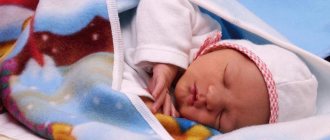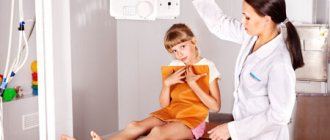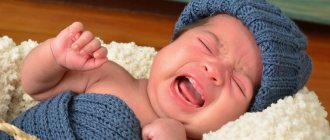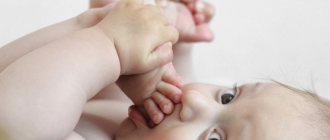Nutrition
- The first day - 10 ml per feeding, until the 10th day the volume increases by 10 ml:
- First day 10 ml per feeding,
- Second day 20 ml,
- Third day 30 ml,
- Tenth day 100 ml.
- From 70 to 100 grams per feeding - up to three months.
Nutritional intake from one week to three months:
Weight: 5 = number of ml per day (2650: 5 = 530 ml per day. 530: 8 feedings = 70 ml)
After feeding, walk in a “column” to burp (also helps with hiccups). If a child drinks water, give it if the body doesn’t need it and won’t drink it.
Bathing
For the first month, it is recommended to bathe the child in a solution of potassium permanganate (until the umbilical wound heals). Bath the child at night every day at a temperature of 37 degrees, adding herbs or a baby bathing product. They bathe him for at least five minutes if he doesn’t cry (we increased it to 30 minutes). Wash with baby soap once a week. During bathing, from three months onwards, they develop - they help push off the edge of the bathtub with their feet, hit the water with their hands, stamp their feet in the water, play with a ball, etc. Hardening - pour over after bathing, gradually lowering the water by a degree.
Toilet
After bathing, for the first 3-4 months, coat all folds (knees, elbows, groins, behind the ears, neck) with a solution of olive oil, steamed for 20 minutes in a water bath. The navel is treated with a solution of brilliant green, preferably Chlorophyllipt, until the wound heals. The eyes are washed with lukewarm boiled water to the spout in the morning and at night. The spout is coated with wicks moistened with olive oil to avoid dry crusts. For girls, wash only from front to back. For boys, carefully open the foreskin and rinse with a weak solution of potassium permanganate every day until it opens completely, then with potassium permanganate once a week; open while washing every day or every other day.
List of items and things needed for a newborn after discharge from the hospital
Now, if the birth went without complications and the baby and mother feel well, they are discharged from the maternity hospital after 3-4 days. During this time, the young father and other relatives need to prepare the space for the newborn as much as possible and purchase necessary and useful goods, if they were not purchased in advance.
A complete list of what a baby will need in the first month:
- Crib, mattress, blanket, bed linen. For newborns, it is recommended to buy special mattresses made from natural fillings for their cribs. It is better to take a blanket from hypoallergenic materials, for example, combed sheep wool. Pediatricians do not recommend buying a pillow for a baby under one year old;
- Stroller with cradle. The stroller needs a small mattress, a mosquito net, and a rain cover. If the baby was born in winter, the stroller will need a blanket or a warm envelope-blanket, for example, made of sheepskin; you can also buy or sew additional insulated covers and a muff for the handle so that the mother’s hands do not freeze during walks;
- Bath, slide or mattress, bathing products (soap, baby shampoo, body gel, bubble bath, herbs), special towel. Pediatricians advise bathing a newborn in the first weeks, until the navel has healed, in a separate bath, and then in an adult bath, where you can practice infant swimming or swim with a special children's circle around the neck. To make it more comfortable for parents to hold the baby, you can put a plastic slide or a foam mattress in the bath. It is recommended to wash your baby with soap or baby gel no more than 2-3 times a week so as not to dry out his delicate skin. You can use herbs (chamomile, string) or pharmaceutical products containing them to bathe a newborn. It is better to buy a large towel for your baby with a hood or a comfortable corner that will protect his head from the cold after water procedures;
- Baby changing table. Of course, you can change your baby’s clothes on a bed or sofa, but it’s much more convenient on a special table. In the room you can put a chest of drawers for children's things, on the top surface of which there will be a place for changing, or buy a special changing surface that can be placed on a crib or sofa;
- Packaging of diapers for newborns, you can choose models for a boy or a girl, or size “1” of a brand suitable for the baby;
- Packaging of hypoallergenic baby wipes;
- Hygiene products: baby body milk, oil, powder, diaper cream;
- Children's nail scissors, tongs to remove overgrown nails; Means for treating the navel (brilliant green, peroxide), if the pediatrician advises doing so;
- Disposable diapers and baby oilcloth to cover while changing the newborn and in the crib for sleeping;
- Baby soap or baby laundry detergent;
- Sets of clothes depending on the time of year.
Dream
- Newborns - 16-18 hours a day;
- 3 weeks - 15-18 per day;
- 6 weeks - 15-16 hours a day;
- 4 months 10-12 hours of night sleep + two short naps during the day, 2 hours each;
- 6 months 10-11 hours of night sleep + two short naps during the day, 2 hours each;
- 9-18 months - 10-11 hours of night sleep + 2 short naps during the day, 1-2 hours each.
The child sleeps in turn on each side (put a bolster under the backrest), without a pillow (you can put a book under the mattress for a slight tilt). When he wakes up, he lies on his back, but not after eating.
You can check if your child is cold by touching his nose - if it’s not cold, everything is fine. You can check if it’s hot by sticking your finger in your collar - if you’re not sweating, everything’s fine.
Charger
All newborn babies have increased muscle tone. To remove it, start every morning by stroking the body, trying to gently relax it, unclench your fingers, straighten your arms and legs. Very gentle and careful. From the first days, when he is awake, place him on his tummy (under supervision) so that he learns to hold his head up.
From the age of one month, perform a light stroking massage 1-2 times a day - arms, legs from bottom to top, chest, back, stomach - clockwise. Hands, feet - draw a figure eight, massage your fingers. Exercise therapy - arms up, to the sides, hug yourself. Legs in a circular motion from the hips to the sides. Knees to tummy - straighten. Develop reflexes - stomp, stroke the back to make it arch, give fingers to grab.
Exercise for the eyes: move the toy to the right, left, up, down, towards the spout, away from the spout, the child’s head is fixed, watching with his eyes.
The first days of a newborn’s life - introduction to the world and important examinations
First day of a newborn's life
During childbirth, the child experiences stress along with the mother. Once in this world, he is scared and anxious, expressing his displeasure by screaming after clearing mucus from his nasal passages. If the birth is successful, then it is considered obligatory to place the baby, while the umbilical cord is pulsating, on the mother’s stomach. Such a meeting helps to form an inextricable bond between them. The familiar warmth and beating heart gives the baby a feeling of peace after the stress he has experienced. Afterwards, the umbilical cord is cut, and the newborn is taken away to once again clear the nasal and oral cavities of debris using a rubber bulb, and check his ability to live. There is an examination for the number of fingers, the functionality of the arms and legs, the genitals are examined, and the heartbeat is listened to. The umbilical cord is clamped with forceps and staples are placed on it.
If the birth occurs by caesarean section, the baby is immediately examined by a midwife, since often, during such births, more amniotic fluid enters the baby’s stomach than when it passes through the natural birth canal. The stomach is emptied using a probe and the baby also lies on his stomach next to his mother for half a minute.
Assessment of readiness for a new life
The newborn is laid out on a special heated table, this allows him not to feel the temperature difference after the mother’s warm belly.
Apgar score
The first to conduct a close examination is the neonatologist, who monitors the baby’s condition, according to the Apgar scale, in the first five minutes of his life. This system, consisting of a ten-point scale, allows you to accurately determine whether the child needs additional specialized help.
The Apgar scale includes several assessment criteria:
- The speed and volume of the scream . If the baby is unable to breathe and the first cry does not occur, this is scored as zero points. Late screaming and infrequent weak breathing have a criterion of one point. When the first cry is loud and timely, and breathing is rhythmic, the neonatologist gives two points.
- Heartbeat . Since babies have a small lung capacity and breathing quite frequently, the heart beats very quickly. The norm is considered to be up to 140 beats per minute. If the number of heart rhythms is at least one hundred, the baby is given two points. For fewer hits, one point is awarded. The absence of a heartbeat is zero on the Apgar scale.
- Skin coloring . A slight bluish coloration of the skin for the first time, after birth, is considered normal, but if the blue color does not go away, then oxygen starvation of the baby is suspected. Therefore, blue skin is scored zero points. When only the limbs are blue, the neonatologist gives one point. In a healthy baby, after the first breath, the skin begins to acquire a completely pink color, which corresponds to two points.
- Presence of newborn reflexes . The very first reflex in infants is a reaction to external stimuli: low air temperature, bright light, loud sounds. If the baby grimaces in response to a stimulus, or cries, then he deserves a mark of two points. Weakly expressed reflexes are scored one point. The absence of these has a zero rating.
- Muscle tone . When a child is lethargic, his hands are deprived of even the slightest tension, a mark is given - zero. Weak muscle tone - 1 point. If the child’s fists are clenched and the legs are tucked towards the tummy, then we can say that the muscle tone of such a newborn is normal and equals two points.
By the end of the fifth minute, the neonatologist sums up the results, which results in a score on the Apgar scale.
- The noma range includes scores from 8-10 points .
- A condition of 7 points is regarded as average.
- The final score of 6-4 points and below characterizes the serious condition of the baby, who requires urgent resuscitation care of varying degrees.
A young mother needs to know that Apgar scores are not a consequence of the baby’s level of development, they only show how much the baby adapts to the new environment.
If everything is fine with the child, he passes into the hands of a midwife and a nurse. Initially, the baby is wiped, removing blood, mucus and vernix from the surface of his skin, using napkins or a damp cloth. The doctor weighs the newborn, measures the parameters of the chest and head, and records the height. Changes in these parameters in the future will be controlled by the local pediatrician. Be sure to treat the eyes with a weak solution of albucid to prevent eye inflammation. Honey. The sister takes blood for analysis from the baby’s heel to prevent internal inflammation and determine the baby’s Rh factor. At the end of the initial examination, a personalized bracelet with the mother’s initials is put on the newborn’s wrist. Then comes the turn of clothes, this moment depends on the rules of the maternity hospital: in many, until now, only swaddling is allowed.
First screening
On the third day of being in the maternity hospital, blood is taken from the child’s heel and its traces are imprinted on a special form. This procedure is carried out to detect possible congenital genetic diseases.
This includes:
- A disease associated with an imbalance of amino acids (phenylketonuria);
- Thyroid gland dysfunction (hypothyroidism);
- Adrenal dysfunction, causing excessive release of male hormones (adrenogenital syndrome);
- Metabolic disorder in the conversion of glucose from galactose (galactosemia);
- Dysfunction of the respiratory system and pancreas (cystic fibrosis).
If any disease is confirmed, the baby will need urgent treatment.
First vaccinations
The first vaccination against tuberculosis (BCG) and hepatitis B is carried out within the walls of the maternity hospital. Parents have the right to write a refusal of vaccinations even before the baby is born. But in this case, one should realize the full responsibility of this action. A baby's fragile immune system is susceptible to various diseases that can leave terrible consequences on his health. Therefore, it is so important to protect the newborn from diseases through vaccination.
Appearance of a newborn
It happens that young mothers are frightened by the appearance of their baby. The discrepancy between reality and expectations is reflected.
- Head . If there was a natural birth, then the baby’s head has an oval or even flattened shape, due to the passage through the narrow birth canal; the narrower the woman’s pelvis, the more egg-shaped the shape of the baby’s head. But in order to dispel the fears of young mothers, doctors assure that by 5-6 months the shape of the skull will be rounded. On the parietal part there is a non-ossified area called the fontanel. Under no circumstances should you constantly touch it, as there is a risk of pushing through the membranous tissue. By the age of one and a half years, the fontanel closes completely.
- Eyes . Your baby's eyelids may be slightly swollen due to the pressure he experienced during childbirth. Over time, the swelling subsides. The newborn still has poor control of the eye muscles, so the impression of slight strabismus may be created. Many children have an infant iris color, a gray-blue hue, which will begin to change within a couple of months.
- Nose . The small spout, due to the narrow passages, cannot allow a large volume of air to pass through. That's why babies breathe so quickly, reaching up to 40 breaths per minute.
- Color of the skin . The skin has a pink tint. But the so-called “newborn jaundice” is often observed, which manifests itself on the second or third day. It is a consequence of an immature system for transporting bilirubin in the blood. Physiological jaundice disappears within seven days. Excessive redness of the skin is also possible, caused by the expansion of capillaries due to the cool environment, to which the baby is not yet accustomed to after the mother’s warm belly.
- Weight . The most unstable characteristic of a newborn child. The baby loses significant weight in the first day due to a decrease in swelling and the release of meconium (original feces) from the intestines. If the baby has enough colostrum, then within a day the baby begins to gain weight. When this does not happen, doctors and breastfeeding specialists come to the rescue. The rate of weight loss in newborns is no more than ten percent of total body weight.
Nutrition of a newborn in the first days of life
It's no secret that mother's milk is the best nutrition for the baby. This way, he not only receives important vitamins and microelements for good growth and development, but also has an arsenal of antibodies to common diseases. Therefore, if a mother breastfeeds her child, the risk of him getting sick is sharply reduced.
- For successful breastfeeding, it is important to ensure that the newborn is first applied to the breast within thirty minutes after birth. This way he will receive colostrum, which will populate the gastrointestinal tract with beneficial bacteria that promote proper digestion. During breastfeeding, a woman's uterus contracts under the influence of the joy hormone oxytocin. This contributes to the rapid recovery of the young mother after childbirth.
- The first few days the baby receives colostrum, which is replaced by milk on the third day. In order for this process to happen as quickly as possible, breastfeeding occurs at the child’s first request. Also, doctors recommend that mothers drink enough fluids.
- The basis for the rapid flow of milk and the baby’s weight gain is also the correct attachment of a newborn to the breast. The child's complete capture of not only the nipple, but also the areola provides better stimulation of the mammary glands.
- The use of pacifiers, bottles and artificial formula is strictly prohibited in the first weeks while lactation is being regulated. Otherwise, this may lead to the cessation of feeding due to the baby’s refusal to breastfeed.
Shared stay
Most modern maternity hospitals have switched to a system where the baby and mother stay together in the same room.
This contributes to:
- Good lactation, since the mother gives breast, not according to a schedule, but when the baby wants;
- Stable emotional state of both the child and the mother;
- Strengthening the bond between mother and newborn;
- A new parent will learn the basics of caring for a baby under the strict guidance of medical staff.
Choosing a single room or a shared room is an individual choice for each parent. But for the mother’s emotional stability, it is better to give preference to a general ward. This guarantees mutual help from the same mothers and a pleasant pastime that will not give you a reason to get bored, since in the first days babies mostly sleep if they are not bothered by hunger, temperature changes or pain. Many mothers worry that the screaming of other children may disturb their child's sleep. In fact, a newborn does not react to extraneous sounds of a cyclical nature; only sharp and very loud sounds made at a close distance from them can disturb the baby.
Home!
After four days, if the baby is gaining weight well and the tests are normal, the mother and child go home. After a caesarean section this happens within a week. By this time, the dried umbilical cord flagellum usually falls off. On the day of discharge, the child is once again closely examined by a neonatologist, and the pediatrician talks with the young mother about how to properly care for the baby at home.
On the day of discharge, young parents receive a certificate of birth of their child, with the help of which a new citizen of the country is registered at the registry office. Records are also provided for the baby’s future medical record, which reflects all indicators of the newborn’s physical condition.
Before discharge, it is important to worry about how the baby will get home. For safe travel, a child car seat should be installed. Also, the tasks of the young father or relatives include preparing a clean and bright children's room for the baby.
Now the newborn will be under the supervision of a local pediatrician, to whom young parents should contact regarding the care and health of the baby.
Caring for a baby in the first days of life, advice from a pediatrician
- It is advisable to give preference to breastfeeding as a type of feeding. If you have problems with lactation, you should seek help from a breastfeeding specialist.
- Swaddling is considered a relic of the past. A child who is not swaddled develops much faster due to his high mobility.
- For good digestion, the baby is placed on his tummy before each feeding.
- The room where the baby is located must be regularly ventilated.
- It is not recommended to wrap your baby in clothes that are too warm to prevent overheating. For this purpose, the child’s body temperature is measured daily. It is considered normal if the thermometer shows from 36.6 to 37.3 degrees. The highest norm is a reason to undress the baby.
- Do not introduce a pacifier or bottle until breastfeeding is fully established. This happens when the baby is one month old.
- The baby's eyes and umbilical wound require careful care. To avoid inflammation in these areas, they should be treated as recommended by your doctor.
- It is considered necessary to bathe the baby daily and wash it after each diaper change.
The birth of a new person is a happy event for new parents. Now on the shoulders of mom and dad lies all the care for the baby from the first days of life, responsibility for his health and successful development.
Very helpful:
- listen to music;
- read rhymes, jokes to the baby, coo with him;
- touch different fabrics (curtains, clothes);
- teach to reach for a toy, then hold it.
- from three months - take it by the hands and gently swing it - like a watch (to the sides); like a swing - forward, backward; up down. Learn to roll over onto your tummy using your leg, helping to roll over and back. Give your legs support so that you can learn to push off and crawl. You can sit your child down only after he or she sits down.
Child development and behavior
At 3 months, the main achievement in the child’s development is the ability to hold his head confidently, as well as accurately monitor the movement of objects in front of him.
The baby enjoys watching his favorite toys, as well as his mother’s face. By this time, binocular vision is established, that is, the child learns to see with two eyes at the same time. This ability allows you not only to monitor the movement of objects, but also to estimate the distance to them. At 3 months, the baby will not only smile, but also laugh. The reason for cheerful laughter can be a sincere smile of an adult. At this age, children love to be tickled or actively played with, for example, tossed into the air.
By this age, the abilities of sound communications are actively developing. Gradually, gestures appear that may indicate the expression of certain needs. For example, a baby may clap his hands, thereby saying that he wants to be in his parents' arms. At 3 months, babies don't like being left alone in the crib for long periods of time. It is much more interesting to look at surrounding objects or play with adults.
The baby may often put his fingers into his mouth and use them instead of a pacifier. Sometimes even a whole fist fits into the mouth.
Diseases
- Allergies: Mom: “Entegnin” (sorbent) 6 tablets / 2 times a day.
- Baby:
- "Entegnin" ½ tablet / 20 ml water;
- "Fenistil" (antihistamine) 2 drops / 3 times a day;
- Bath in a solution of 10 bay leaves per glass of boiling water;
- “Tsindol” to smear.
- Stroke the tummy with the outside of your palm clockwise.
This is only personal experience; for all questions, it is better to immediately consult a doctor.
All serious illnesses are prescribed only by a doctor after examining the child.
Adaptation to the outside world
After the birth of the baby, the mother has a lot of worries, because the baby seems so small and helpless. In order not to worry in vain, you need to know what changes occur in the child’s body:
- Physiological weight loss. In the first 3-4 days of life, the child loses approximately 10% of his initial weight and this is the absolute norm. Weight usually returns within 7-10 days.
- Erythema of newborns. During the first days, the child’s skin may be covered with a characteristic small rash, which manifests itself against a background of redness of the skin. This is a normal adaptive reaction that does not cause concern to the baby. It usually goes away on its own within 2-3 days.
- Transient jaundice. This condition occurs due to the accumulation of free bilirubin in the blood and tissues. From the second full day of life, the baby’s skin and sclera acquire a jaundiced tint, but this does not affect his well-being in any way. The condition of the skin usually normalizes before 3 weeks of life, but sometimes jaundice lasts up to 1.5 months, and this requires observation by a pediatrician.
- Sexual crisis. This is a condition when some of the maternal estrogen passes to the baby while still inside the womb or already during breastfeeding. The baby may experience engorgement of the mammary glands. Girls experience slight bleeding from the vagina - it lasts no more than 2-3 days, and the volume of discharge does not exceed 2 ml.
- Meconium. In the first days of life, the baby defecates with original feces - meconium. It is a viscous and thick mass of dark color. Subsequently, the consistency of the stool becomes mushy and the color becomes yellowish-brown.
These conditions are normal for a baby in the first days after birth. You should be wary only if one of them lasts longer than usual or is accompanied by other unpleasant symptoms.









